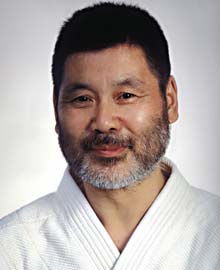
Sugano Sensei was born in 1939 in Otaru, Hokkaido and entered Hombu Dojo in 1957. He had been studying judo for six years when he read about Aikido in a magazine and went to Hombu Dojo to begin his training. After about a year, he entered the uchi deshi program.
“I wanted to be able to pursue Aikido exclusively,” he remembered. That period was very intense for Sugano; he was completely focused on training and on O-Sensei. “To me,” he said, “O-Sensei was the zenith. My training was geared entirely to striving toward that peak.”
Despite his proximity to many of the legendary masters of Aikido teaching at Hombu Dojo in the late 1950s and early 1960s, “I wasn’t really conscious of the high-level teachers around me,” Sugano said. But O-Sensei made an indelible impression. “The first time I saw him, he appeared to me as a religious master or leader rather than a martial artist. In his movement there was some energy moving but not visible, so you feel there’s nothing there, yet you feel this sort of strong core of steel. Yes, I thought of him very much more like a religious leader. He expressed himself with the physical form, but it was a quite a different thing when he was throwing each of us.”
Although Sugano Sensei points out that none of O-Sensei’s students adopted the exact religion (Omoto Kyo, a sort of mystical Shinto) O-Sensei so strongly believed in, it was through his spiritual and religious beliefs that O-Sensei transmitted Aikido. His approach changed Aikido from a traditional martial art to something new, according to Sugano Sensei. “I think Aikido is so unique because O-Sensei broke with so-called traditional martial arts concepts. As I studied Aikido, I tried to always get back to that point. It’s not just how you do techniques. Generally in the martial arts, there is a system of fighting technique, but he broke with that concept, and that to me is the most important part”.
“Partly I think he made me more aware that Aikido was something I had to continue to search for. He didn’t provide any system; he had some system so that you’re always following up, but he wasn’t providing it. The individual person had to search for himself. “Maybe what one person wants, another doesn’t. For me that could be the influence I got from him. Even where we’re teaching technically no one is just like him. He was a unique person so no one could really copy him. So, perhaps the biggest influence from him is probably to make each person free to search for something individually.”

Sugano Sensei with members of Blue Mountains Aikido. Summer school 2010.
Sugano Sensei’s own path led him to live and teach in different parts of the world. In 1965, he moved to Australia, staying for thirteen years and establishing a strong base of Aikido throughout Australia. He then he moved to Belgium and began teaching throughout Europe before moving to New York City.
In 2003 Sugano Sensei lost his left leg below the knee to a bacterial infection, but he continued to teach and demonstrate aikido without any severe limitation. Sugano Sensei passed away in New York City on August 29, 2010 to the sadness of all who knew him.
